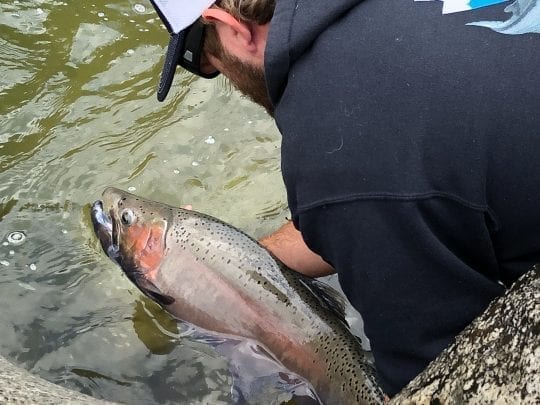Fall Fly Fishing Report 2018
Year of the Super Trout
By Michael Wier
2018 is hands down the best trout season I can remember in the last couple of decades! Seems like everywhere I go, I have been seeing and catching big trout. And every time I look at social media there’s another photo of a huge trout from a California fishery. It’s not just that I’m targeting bigger fish this year either. I’ve been primarily using the same techniques and flies designed to target larger fish for many years now. There’s simply just more big fish around this season.

Not all big fish eat big food sources. This large rainbow fell for a size #18 mayfly imitation. Don’t be afraid to use small flies even when you’re targeting large trout.
My theory: I think there’s an age class of trout (now 4-7 years old) that survived the drought and are now thriving. During the years of drought from 2012-2016, resources were scarce. Fishery temperatures warmed up and the water level dropped down in many of our systems. As the drought worsened in 2014-2016, spawning conditions deteriorated as well. Despite these hardships, some fish prevailed. Especially in systems where trout had access to lakes or cold water springs, which allowed them to lay low and ride out the tough conditions in the rivers and streams. Then the winter of 2017 hit, one of the wettest years on record. All of our rivers, streams, and lakes received a much needed boost of cold water. Because there was so much water, many of the prime rivers were essentially inaccessible for fishing for most of that season which took a lot of pressure off the fish and gave them some time to rebound.

Under the right conditions, wild trout can grow to impressive sizes. Water temperature, dissolved oxygen, food availability, competition, and predator dynamics are some of the key factors that influence how fast trout grow. Availability of habitat then determines how big they can grow.
Winter of 2018 provided decent precipitation, though nowhere near as much as 2017. For the most part, the combination of a high water year followed by an average water year created ideal river conditions for trout as well as many other freshwater fishes. These prime river and lake conditions were optimal for successful spawning. Trout, steelhead, and salmon had good spawning conditions and so did many other species we often overlook but that are a huge part of the ecosystem and part of the food web for salmonids. Fish like sculpin, Lahontan redside, chubs, dace, pikeminnow, and various suckers. Conditions in 2018 have also been optimal for aquatic and terrestrial insects to rebound.

Angler Jason Shields with a brightly colored brown trout. Though not originally native to California, brown trout are surprisingly resilient and well adapted to the conditions of California’s lakes and rivers.
I believe those lucky wild trout that survived the drought are now flourishing. River conditions have been great all season and there has been plenty of food around. This, combined with less competition for those food sources, has created a class of super trout! However, all our fisheries are constantly fluctuating depending on environmental factors and these conditions won’t last forever. If you’ve been putting off fishing in 2018, now is the time to get out there.

When handling trout, try to keep them in the water as much as possible. After removing the fly, Wier quickly displays this brown trout for a photo but keeps the head and gills mostly in the water. The longer they are exposed to oxygen the harder it is for a trout to recover after being caught and released.
From what I’ve seen, fishing conditions remain great across the state and fall is one of my favorite times to be on the water. Cold nights bring the water temperatures back down to prime feeding conditions for trout. The summer crowds are dying down and so are the predominant afternoon winds associated with the high-pressure bubble. And of course, you can’t beat the fall colors as our native foliage changes into its winter mode. Remember to always use good catch and release practices for wild trout, handle them with care and as always, #KeepEmWet.

CalTrout supports catch and release angling.
Michael Wier is CalTrout’s roving videographer and storyteller. He’s quick to admit his favorite perk of his job is getting to visit some of California’s best wild trout fisheries and interacting with these beautiful creatures whether it’s photographing or catching them.





